

How to analyze an artwork: a step-by-step guide. Last Updated on November 30, 2018 This article has been written for high school art students who are working upon a critical study of art, sketchbook annotation or an essay-based artist study.
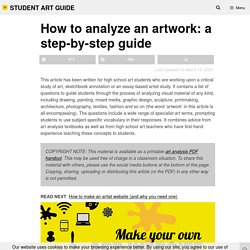
It contains a list of questions to guide students through the process of analyzing visual material of any kind, including drawing, painting, mixed media, graphic design, sculpture, printmaking, architecture, photography, textiles, fashion and so on (the word ‘artwork’ in this article is all-encompassing). The questions include a wide range of specialist art terms, prompting students to use subject-specific vocabulary in their responses. It combines advice from art analysis textbooks as well as from high school art teachers who have first-hand experience teaching these concepts to students. Is It Good Art? Were Van Gogh & Pollock Real Artists? Vincent van Gogh and Jackson Pollock.
The paintings of Van Gogh and Jackson Pollock may seem totally unrelated, but according to a computer scientist at Lawrence Technological University, the artistic techniques of the two famous artists have a lot in common.
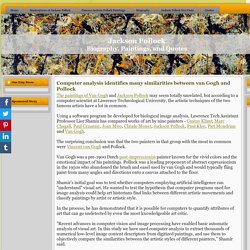
Using a software program he developed for biological image analysis, Lawrence Tech Assistant Professor Lior Shamir has compared works of art by nine painters - Gustav Klimt, Marc Chagall, Paul Cezanne, Joan Miro, Claude Monet, Jackson Pollock, Paul Klee, Piet Mondrian and Van Gogh. The surprising conclusion was that the two painters in that group with the most in common were Vincent van Gogh and Pollock.
Van Gogh was a pre-1900 Dutch post-impressionist painter known for the vivid colors and the emotional impact of his paintings. Pollock was a leading proponent of abstract expressionism in the 1950s who abandoned the brush and easel used by van Gogh and would typically fling paint from many angles and directions onto a canvas attached to the floor. Qi in Modern Art: Vincent van Gogh and Jackson Pollock. By John Voigt Qi (life force energy) is the vehicle and expression of the beauty, emotions and passions of art.[1] The two painters Vincent van Gogh and Jackson Pollock were masters who in their outer visions and inner torments (both died in apparent suicides) saw, and experienced Qi; then translated this vision to their art so the observer could partake in the explosion of the beauty and pain of life.

10 fresh art and design blogs for creative inspiration. From photo-focused blogs to in-depth articles, there’s a wealth of inspiration and advice for creatives to find on the web.
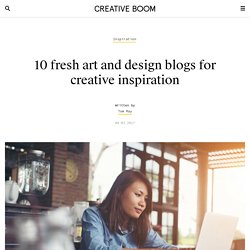
But the sheer number of art and design focused blogs can be truly overwhelming, and in all honesty, many of them are pretty substandard. In this post, we’ve sifted through the thousands of blogs vying for your attention, and picked out the diamonds in the rough. These 10 sites are all great places to get inspired by new ideas. 1. Surface Surface is an American print magazine, publishing 10 editions a year. 2. Mindsparkle aims to be "more than a high quality online magazine... a platform for likeminded people sharing the same values". 3.
News - a-n The Artists Information Company. This week’s selection features exhibitions, talks and projects presented via online viewing rooms, social media and other online platforms, plus newly reopened physical spaces, including: Elizabeth Price’s new Artangel commission in London, Kathy MacCarthy’s mass forms at PEER, London, Stills: Centre for Photography reopening with the collaborative project Elementary Blueprint, plus a free webinar from the Visual Arts Alliance.

Textiles artist discusses how arts organisations need to better engage deaf and disabled artists, and how the coronavirus pandemic presents a time for change and opportunity. Moscow based photographer wins £15,000, plus an additional £1,250 for being the winner of the Mental Health series category, in prize designed to help combat health taboos. Reflective Journal. How to a annotate Sketchbook.
Presdales Art GCSE guide 1. GCSE16 artdes written annotation guide. Reflective writing in Arts. What is reflective or reflexive writing?

Reflective writing is examining the knowledge acquired through reading or through an experience and making connections with other concepts that you have encountered in your learning. Reflective Writing Introduction. Reflective assignments are different to standard essays.
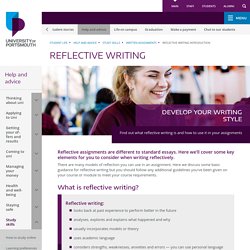
Here we'll cover some key elements for you to consider when writing reflectively. There are many models of reflection you can use in an assignment. Here we discuss some basic guidance for reflective writing but you should follow any additional guidelines you've been given on your course or module to meet your course requirements. What is reflective writing? Thinking reflectively Thinking reflectively involves: Thinking about what was done. Sketchbook handout 1. Studio knowledge object. Self Reflection Writing - BTEC GRAPHIC DESIGN. Writing the A2 Art Personal Study: Examples, Help and Guidance. This article has been written for CIE A Level Art students who are working on their A2 Art Personal Study.

It focuses purely on how to write the text of the Study; a previous article outlines how to come up with a good topic; a future article will address the illustrations and presentation methods. The Personal Study is an area of uncertainty for many A Level Art students. It differs from projects that are usually completed within high school Art programmes, as it involves a substantial written component (maximum 3,500 words) – something which can intimidate students, especially if they are unfamiliar with how to critically analyse an artwork, make informed judgements and write personal evaluations. With few examples of quality Personal Studies available, it can be difficult to know what is expected and how to begin.
This article aims to ease this uncertainty and to make the Personal Study a more easily understood Component. 1. 2. 3. Introduction. 4. How to Write an Art Comparison Essay. Writing an art comparison essay can be a difficult task for the novice art student.
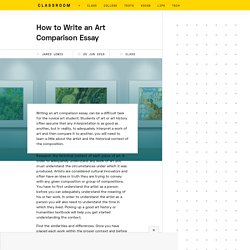
Students of art or art history often assume that any interpretation is as good as another, but in reality, to adequately interpret a work of art and then compare it to another, you will need to learn a little about the artist and the historical context of the composition. Research the historical context of each piece of art. In order to adequately understand any work of art you must understand the circumstances under which it was produced. Artists are considered cultural innovators and often have an idea or truth they are trying to convey with any given composition or group of compositions. You have to first understand the artist as a person before you can adequately understand the meaning of his or her work. Find the similarities and differences. Consider the medium through which the piece of art was created. Compose your essay. Revise your work. Two Art Periods: Free Compare and Contrast Essay Sample.
Renaissance and Neoclassicism are two major periods in the history of art, during which different forms of art including architecture, painting, music, and visual arts significantly progressed.

During these eras, many artists gained enormous fame as a result of the masterpieces they produced, reflecting how the ideologies and artistic philosophies evolved during that time. This essay compares and contrasts these two art periods with respect to the major works created by prominent artists. In this regard, the masterpiece David, created by Michelangelo has been compared with Antonio Canova’s statue Psyche Revived by Cupid’s Kiss. Both of these works reflect the artistic progression of their ages. David represents Renaissance art by reflecting the political situation of that time, whereas Psyche Revised by Cupid’s Kiss depicts the artist’s focus on classical Greek and Roman styles. The Renaissance Era refers to a period of rebirth in art.
Art Critique -Compare Two Pieces / 2. “The Mona Lisa “1503-1517 painting by Italian painter Leonardo da Vinci. And “Self-Portrait with Monkey “1938, by Mexican painter Frida Kahlo. Art Critique Process in Spanish: Link: Lesson: Writing about art is not so very different from writing about other subjects. Compare and Contrast: Preparing for an Art History Essay Exam Tutorial. Acknowledgements: Courses in this area are hands-on courses that enable students to present and critically evaluate competing interpretations through written and oral analysis.
Students are expected to distinguish between different artistic and historical schools or periods using the varying approaches and viewpoints characterized by those periods under study. In addition, these courses encourage students to identify the values that underlie the world-views of different cultures and peoples, as well as their own culture(s) over time. Sketchbook handout 1. Reflective writing - Norwich University of the Arts - Library and Learning Support. Art Sketchbook Ideas: Creative Examples to Inspire High School Students. This article provides tips and guidance to help you produce an outstanding high school sketchbook. It contains an online collection of sketchbook pages from different qualifications from around the world, including IGCSE / GCSE Art, A Level Art, VCE Studio Arts, NCEA Level 3 Scholarship and IB Visual Art. Many of the sketchbook pages shown below are from projects that achieved full marks.
Using annotation - Annotating your work - GCSE Art and Design Revision - BBC Bitesize. Improve students' art vocabulary ⋆ felt-tip-pen. Visual Directions. What is a sketchbook? The Term 'Sketchbook' is open to interpretation. It can represent many different things within a variety of contexts. On some courses, it may be referred to, for example as research notebook/journal or a workbook, rather than a sketchbook. A sketchbook can take a range of formats: it may be presented as a book, loose pages, an online portfolio or a combination of all these.
The sketchbook is a personal document - it is about you, your thoughts, your work, your responses and your feelings. The sketchbook is an invaluable place to record your visual experiences. Autodesk SketchBook - Free for Students. We believe in education.